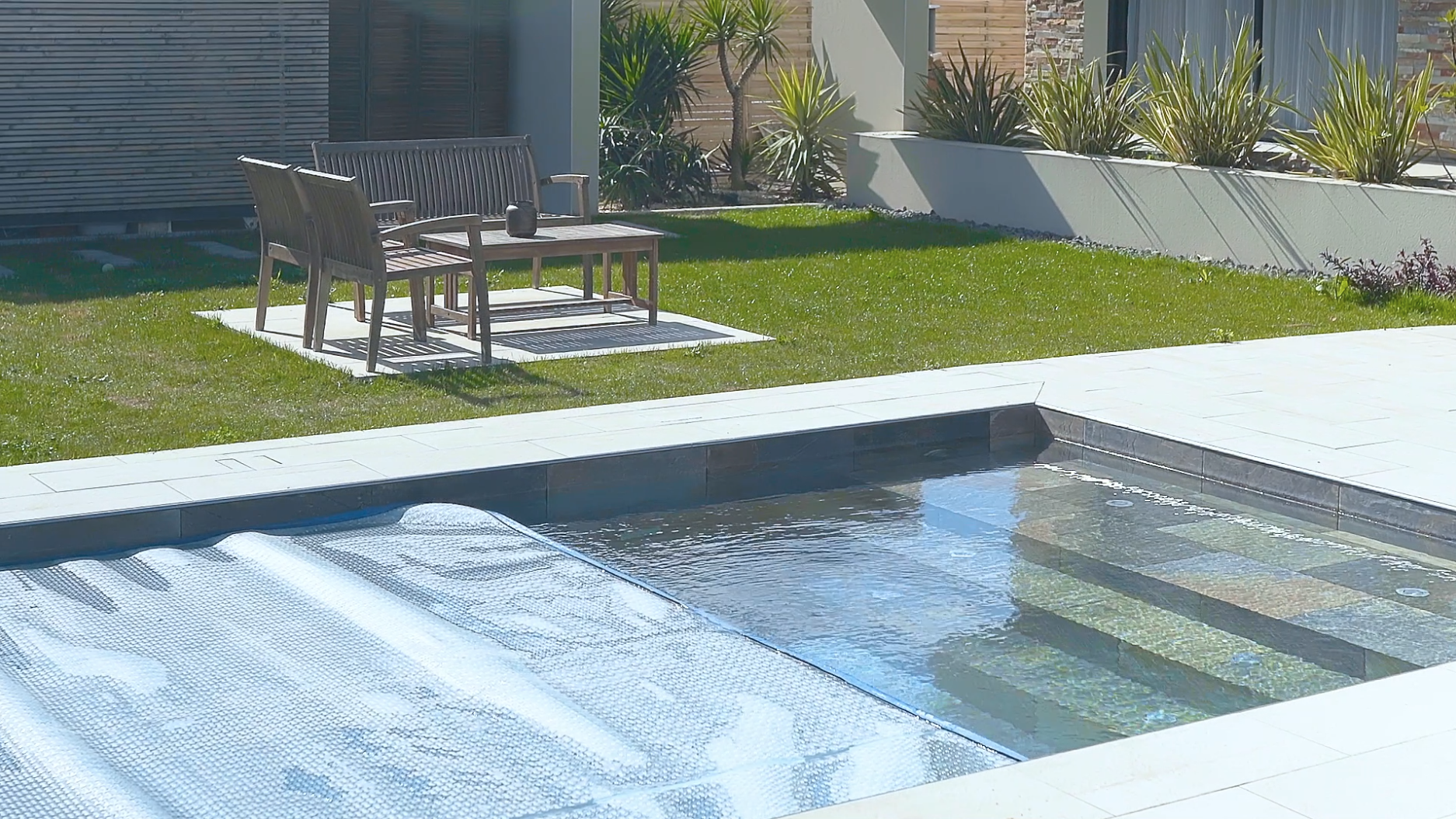“A more sustainable pool must consider the efficient use of water, energy, and reduction in chemical usage in parallel.”

There is a growing environmental awareness and concern for sustainability, and the pool and wellness sector has been adapting its offerings to this context for some time. The emergence of products and technologies that not only enhance your aquatic experience but also significantly contribute to saving resources like water, energy, and chemicals is evident.
So, the question arises: What exactly defines a pool as “efficient,” especially in a global scenario of increasing water scarcity? Fluidra, a global leader in pool and wellness solutions and equipment, offers some enlightening guidelines.
The efficiency of a pool in its usage phase is not measured solely by its functionality but also by its ability to provide a seamless experience for the user while minimizing resource usage. To evaluate efficiency, three main vectors are considered: water consumption, energy expenditure, and chemical usage. While each of these factors can be addressed individually, their collective interaction truly drives the overall efficiency of any aquatic facility.
- – Water Vector: Water consumption in a residential pool is mainly due to evaporation (>60%), losses from filter media washing (>30%), and losses from pool usage and enjoyment (>3%). Structural problems causing leaks in the pool or hydraulic system are not considered here.
1.1. Water Losses due to Evaporation:
Evaporation is a natural phenomenon affecting any body of water in direct contact with the atmosphere. Factors such as water temperature, air temperature, relative humidity, wind, and pool usage directly influence evaporation.
Pool covers are an excellent solution to prevent water loss through evaporation. They act as a barrier between the water surface and the atmosphere and, with proper use, can reduce annual evaporation losses by up to 90% (or 54% of the total pool). It is essential to use a cover that completely covers the surface and use it whenever the pool is not in use. Depending on the type of cover used, it can also serve as a safety feature to prevent accidental falls into the pool, especially for children, seniors, or pets.
1.2. Water Losses due to Filter Washing:
Common filtration systems, whether sand or other similar media, usually require washing the media once it can no longer hold more dirt. This washing is done with pool water that flushes the dirt to the drain. Depending on the washing flow rate and duration, this process can discharge a significant amount of water, which needs to be replenished. Automating the filter washing process is advisable to adjust the total washing time and prevent potential water losses due to negligence.
Using cartridge filters is a good solution as it can significantly reduce the water used for filter washing, leading to savings of up to 80% (or 24% of the total pool). While the washing process is manual, it is highly efficient in water usage. To enhance this efficiency, it is recommended to use specific cleaning solutions that facilitate the cleaning process.
The use of robotic pool cleaners also increases the filtration system’s efficiency. Dirt that accumulates in the pool filter through other cleaning methods is collected in the cleaner’s own basket. This extends the filter’s lifespan between washes, reducing the number of filter washes. Quantifying the savings is challenging as it depends largely on the amount and type of dirt the pool accumulates.
Reducing water consumption is also possible when showering before using the pool. It is recommended to use showers with flow rates equal to or less than 6 liters per minute, equipped with push buttons or timed sensors. Solar showers also provide warm water using solar energy.
Lastly, installing sensors that allow monitoring water consumption in real-time is advisable.
- Energy Vector:
In pools where water is heated, the primary energy consumption is due to water heating, followed by the filtration pump. To a lesser extent, lighting and the disinfection system also contribute to the pool’s energy consumption. Additionally, the pool structure and the properly sized hydraulic system are also important.
Similar to water usage, it is highly recommended to install a solution that allows monitoring energy consumption to adjust operating patterns for maximum energy efficiency while maintaining water quality.
2.1. Energy Consumption for Water Heating:
Heating pool water to temperatures around 25°C consumes a significant amount of energy. Using a high-efficiency heat pump (Seasonal Coefficient of Performance – SCOP* above 4, classes A, B, and C**)
in conjunction with a cover with a low transmission coefficient (classes A and B) is a very efficient solution. Proper use of both elements can reduce the energy needs for heating the pool water by up to 90%. In fact, both elements should always be installed together.
SCOP (Seasonal Coefficient of Performance) ** According to standard EN 17645
Thermal solar solutions, using solar collectors, are also available in the market, allowing pool water to be heated through direct solar radiation. In this case, the temperature increase achieved is usually lower but sufficient in some cases.
Users can also contribute to reducing energy needs by lowering the desired water temperature by 1°C, resulting in an approximate energy savings of 10%.
2.2. Energy Consumption by the Filtration Pump:
In non-heated pools, the filtration pump becomes the largest energy consumer. Variable-speed pumps have been in the market for years and are becoming more popular. These pumps can operate at different speeds based on the pool’s needs, reducing energy consumption by up to 50% or more compared to a fixed-speed pump. The achieved savings depend on the pump usage pattern, i.e., how different speeds are combined to achieve maximum reduction without compromising water quality.
2.3. Other Energy Savings:
Current regulations require the installation of LED lights. The least efficient LED spotlight is five times more efficient than halogen lamps. It is recommended to use light sources with efficiencies above 160 lm/w (classes A, B, and C). The energy savings of LEDs compared to halogens exceed 85%. Regardless of the high-efficiency systems used, it is essential to adjust lighting usage to avoid unnecessary illumination. Remote controls and adjustable timers facilitate optimal usage.
Proper thermal insulation of the pool structure helps minimize heat losses, especially for elevated pools. Solutions with the highest possible thermal balance (NTB > -5 w/m2, classes A and B) are recommended. Additionally, correctly sized pipes are crucial to prevent energy losses (pressure loss). It is recommended to work with maximum water speeds equal to or less than 1.3m/s (class A).
- Chemical Vector:
The consumption of chemicals in a residential pool is mainly due to chlorine derivatives – or other biocides – for water disinfection, pH regulators, and other products to maintain water quality. Monitoring and automating water quality maintenance and seeking professional pool advice for proper equipment sizing are highly recommended.
3.1. Solutions to Reduce Disinfectant Chemical Consumption:
Salt chlorination systems produce “chlorine” from the salt added to the pool, eliminating the need to consume and store chlorinated products. Furthermore, low salinity electrolysis systems allow operation with low salt levels in the water, facilitating possible reuse of drained or washed water for other purposes. Technologies combining salt electrolysis with low-pressure UV radiation, such as Neolisys, offer significantly superior water disinfection and oxidation capabilities.
The use of low-pressure UV or ozone systems can significantly reduce the need for additional disinfectant products, reducing chlorine usage by up to 60%. Some products incorporate silver minerals with bactericidal properties, allowing a reduction in disinfectant doses.
Measurement and dosing equipment for chlorine, free chlorine sensors, and/or Redox sensors, along with chemical dosing systems, enable continuous control of the necessary disinfectant levels, avoiding excesses or shortages.
3.2. Solutions to Reduce Other Chemicals:
Proper pH regulation of water involves dosing acids or bases more or less continuously. Using pH regulator measurement and dosing equipment allows continuous maintenance of the necessary pH levels that favor disinfectant activity. This approach allows better dosage adjustment and prevents excesses.
A solution to avoid using acids is the use of CO2 gas for pH regulation, as in Freepool technology. This technology maintains optimal pH levels without adding strong acids or bases, generating fewer disinfection byproducts. This technology combines Neolysis with CO2 usage, resulting in a 100% reduction in both disinfectant and regulatory chemicals.
Maintaining water in perfect conditions, both in transparency and disinfection, is essential to ensure user enjoyment and safety. Regular monitoring of the pool water quality is vital to ensure that different parameters are correct. Solutions that monitor and provide real-time information on the pool’s parameters are available, such as Aqualink, FluidraPool, or other solutions within Fluidra’s digital ecosystem. When in doubt, always consult a pool professional.

Sustainable Pools, Smart Pools
In an increasingly interconnected environment, the ability to remotely control devices and analyze data in real time allows for faster and more efficient processes and activities.
With precise and measurable data obtained through the Internet of Things (IoT), control and maintenance processes can be precisely adjusted to the pool’s actual needs and automated, resulting in greater efficiency and cost reduction. Connected pools are applicable to both residential and commercial pools. In both cases, a connected pool means a better user experience and more efficient maintenance and repair.
When talking about the future of pools, we are talking about sustainability. The most sustainable pools promote practices and technologies that seek to reduce the carbon footprint impact to the minimum, accompanied by long-term cost savings, minimal maintenance, without compromising optimal water quality. It is essential for the entire value chain, from brands to the end customer, to be aware and implement measures to protect the environment without sacrificing the enjoyment of healthy, sustainable, visually appealing aquatic facilities that contribute to community building and social cohesion.
Cristina Benavides, contributor to Piscina & Wellness Barcelona




